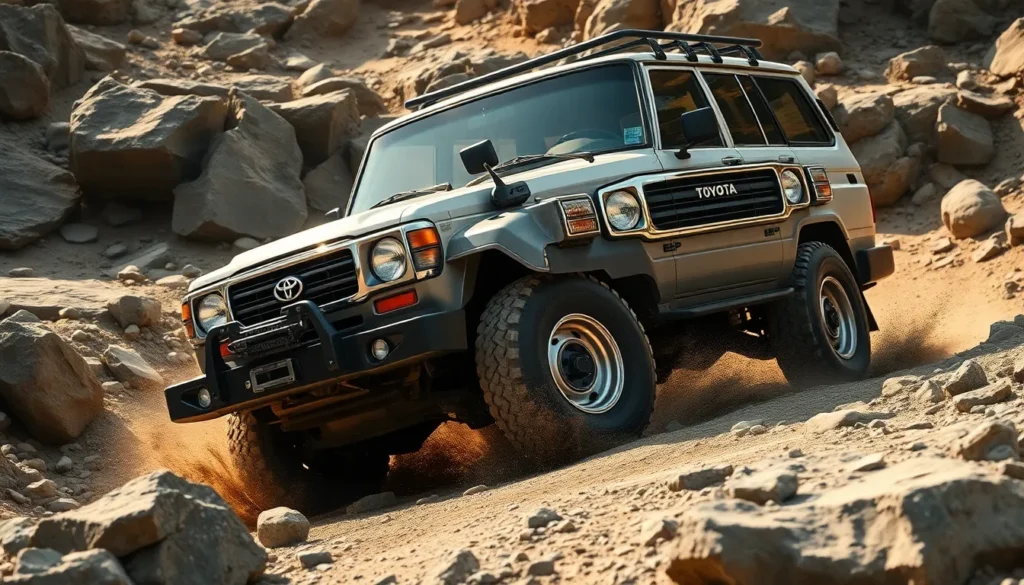We’ve witnessed automotive legends come and go, but few vehicles command the respect and devotion of the Toyota Land Cruiser 70 Series. This isn’t just another SUV – it’s a testament to engineering excellence that’s conquered the industry’s most challenging terrains for over four decades.
While other manufacturers chase fleeting trends, Toyota’s kept the 70 Series fundamentally unchanged because perfection doesn’t need revision. From Australian outback stations to African safari expeditions, this rugged workhorse has earned its reputation as the ultimate go-anywhere vehicle that simply refuses to quit.
Whether you’re a serious off-road enthusiast or someone who demands uncompromising reliability, understanding what makes the Land Cruiser 70 Series special could change how you view capable vehicles forever. We’ll explore why this legendary truck continues to dominate markets worldwide and why it might be the perfect solution for your most demanding adventures.
Toyota Land Cruiser 70 Series Overview
The Toyota Land Cruiser 70 Series stands as one of the most enduring vehicle platforms in automotive history, maintaining production for over four decades with minimal fundamental changes. Originally launched in 1984, this rugged SUV represents Toyota’s commitment to creating vehicles that prioritize functionality and reliability over contemporary styling trends.
Built on a solid foundation of proven engineering principles, the 70 Series offers multiple body configurations including pickup trucks, wagons, and hardtop variants. Each configuration shares the same robust ladder-frame chassis construction that provides exceptional durability in demanding conditions. Toyota designed this platform specifically for markets where vehicle dependability matters more than luxury amenities or fuel economy.
The series currently includes several distinct models that cater to different operational requirements:
- Land Cruiser 70 Pickup (Single Cab) – Features a 2340mm cargo bed for maximum utility
- Land Cruiser 76 Wagon – Offers seating for up to 8 passengers with rear cargo space
- Land Cruiser 78 Hardtop – Provides weather protection with removable rear seating
- Land Cruiser 79 Pickup (Double Cab) – Combines passenger capacity with cargo versatility
Toyota engineers equipped the 70 Series with time-tested mechanical systems that emphasize repairability and parts availability in remote locations. The vehicle features manual transmission options, simple electrical systems, and straightforward mechanical components that local mechanics can service without specialized diagnostic equipment.
Production of the 70 Series continues in select global markets including Australia, the Middle East, and various African countries where terrain demands exceed typical passenger vehicle capabilities. Toyota discontinued sales in many developed markets due to emissions regulations and safety standards, yet maintains production for regions that require its unique combination of durability and simplicity.
We observe that the 70 Series maintains its original design philosophy even though modern automotive trends toward electronic integration and comfort features. This approach creates a vehicle that appeals specifically to users who prioritize mechanical reliability and field serviceability over contemporary amenities.
Design and Build Quality
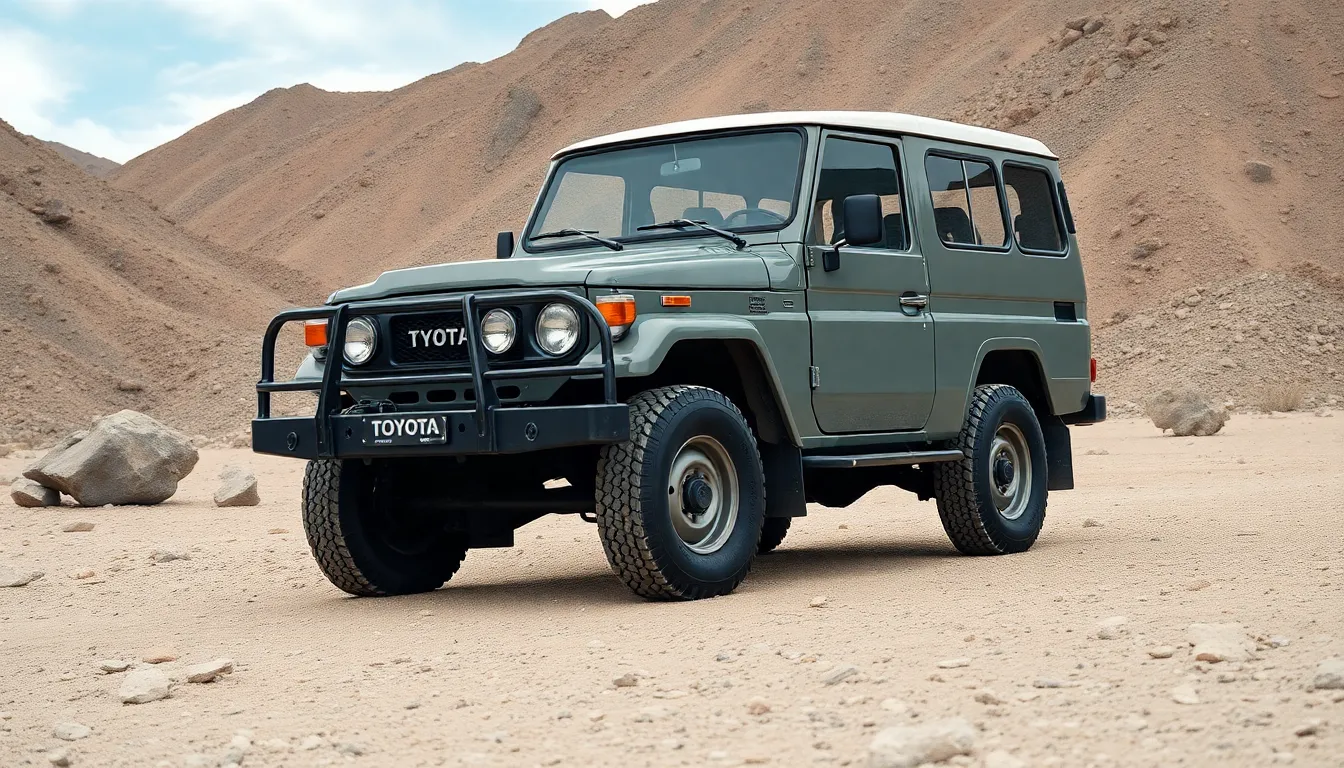
Toyota Land Cruiser 70 Series design prioritizes functionality over aesthetics, creating a purposeful vehicle that withstands decades of harsh use. The build quality reflects Toyota’s engineering philosophy where every component serves durability and reliability.
Exterior Design Features
Boxy silhouette defines the Land Cruiser 70 Series aesthetic, with flat panels and angular lines that maximize interior space while minimizing manufacturing complexity. Steel body panels feature increased thickness compared to modern SUVs, providing superior resistance to dents and corrosion in challenging environments.
Front grille sports a distinctive Toyota emblem surrounded by horizontal chrome bars, maintaining the classic Land Cruiser identity across all model years. Protective elements include steel bumpers, side steps, and wheel arch flares that shield vulnerable areas from rocks and debris.
Round headlights with protective covers dominate the front fascia, offering easy replacement and maintenance in remote locations. Door handles, mirrors, and trim pieces use robust materials designed for frequent use and extreme weather conditions.
Ground clearance reaches 235mm on most variants, allowing the vehicle to traverse obstacles that would stop conventional SUVs. Approach angles of 42 degrees and departure angles of 38 degrees enable confident navigation over steep terrain.
Interior Layout and Materials
Functional cabin design emphasizes practicality with high seating positions that provide excellent visibility across all terrain types. Dashboard layout places essential controls within easy reach, featuring large buttons and switches that operate reliably with gloves.
Vinyl upholstery dominates most surfaces, chosen for its ability to withstand extreme temperatures, moisture, and frequent cleaning. Seat materials resist tearing and fading, maintaining appearance after years of heavy use.
Storage compartments throughout the cabin accommodate tools, maps, and equipment necessary for extended expeditions. Cup holders, door pockets, and overhead compartments use every available space efficiently.
Climate control systems feature robust mechanical components rather than electronic interfaces, ensuring operation in dusty and humid conditions. Air vents direct airflow effectively throughout the spacious cabin.
Instrumentation includes analog gauges for engine temperature, oil pressure, and fuel level, providing clear readings in all lighting conditions. Warning lights use bright colors and clear symbols for immediate recognition of potential issues.
Engine Performance and Specifications
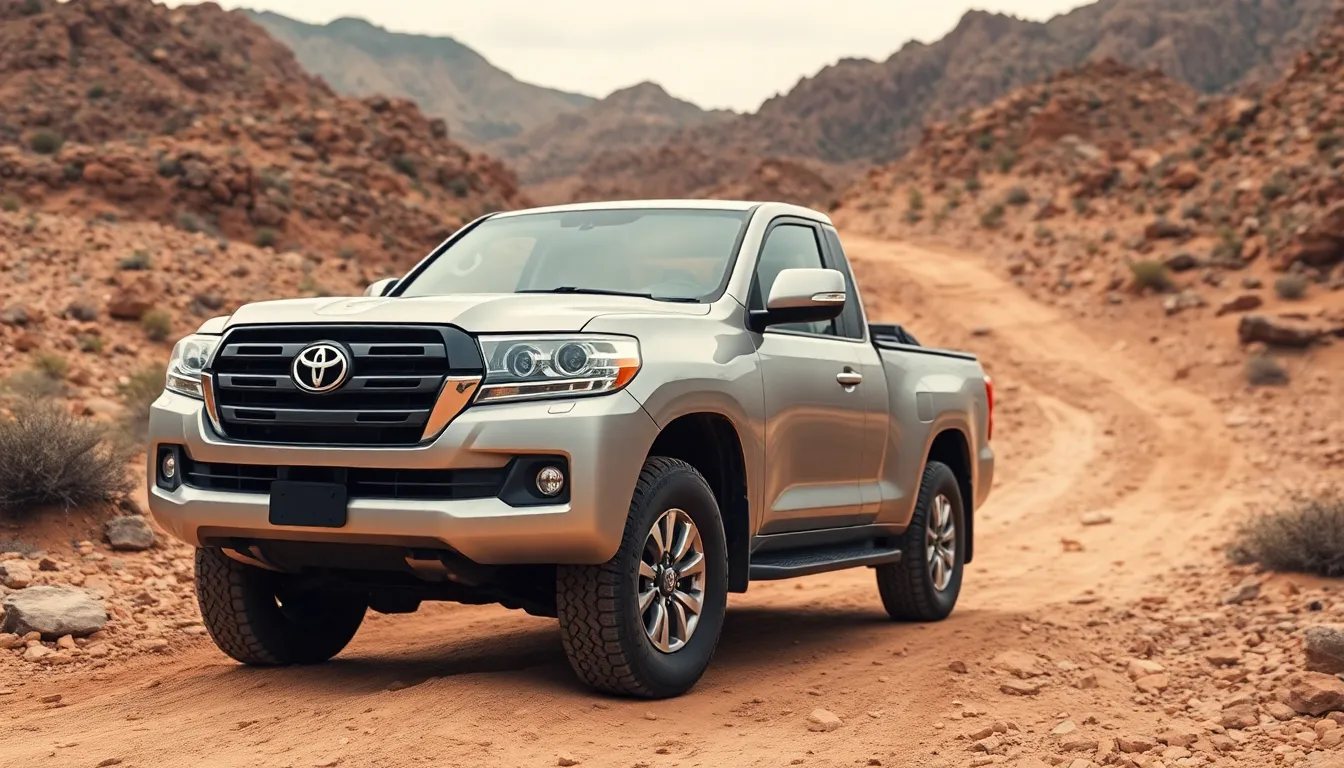
The Land Cruiser 70 Series delivers exceptional engine performance through proven powerplants designed for extreme conditions. Toyota engineers have refined these engines across decades to maximize reliability in challenging environments.
Powertrain Options
Diesel engines form the backbone of the 70 Series lineup across global markets. The 4.5-liter V8 1VD-FTV turbocharged diesel produces 202 horsepower and 430 lb-ft of torque, providing substantial pulling power for heavy loads and steep inclines. This engine features common rail fuel injection technology that enhances combustion efficiency while reducing emissions.
Alternative powertrains include the 4.2-liter 1HZ naturally aspirated diesel engine, generating 130 horsepower and 268 lb-ft of torque. Markets like Australia and Africa receive this robust unit known for its simplicity and field serviceability. The 1HZ engine operates without turbocharging or electronic fuel injection, making repairs accessible with basic tools in remote locations.
Gasoline variants feature the 4.0-liter 1GR-FE V6 engine producing 228 horsepower and 266 lb-ft of torque. This naturally aspirated unit serves markets where diesel fuel quality remains inconsistent or gasoline preference exists. The 1GR-FE engine includes dual VVT-i technology for optimized performance across various RPM ranges.
Transmission options include a 5-speed manual gearbox standard across most configurations. The R151F manual transmission provides direct driver control essential for technical off-road situations. Automatic transmission availability varies by market, with some regions offering a 5-speed automatic for enhanced comfort during highway driving.
| Engine Type | Displacement | Power Output | Torque Output | Fuel System |
|---|---|---|---|---|
| 1VD-FTV Diesel | 4.5L V8 | 202 hp | 430 lb-ft | Turbocharged Common Rail |
| 1HZ Diesel | 4.2L Inline-6 | 130 hp | 268 lb-ft | Naturally Aspirated |
| 1GR-FE Gasoline | 4.0L V6 | 228 hp | 266 lb-ft | Naturally Aspirated VVT-i |
Fuel Economy and Efficiency
Fuel consumption varies significantly based on engine choice and driving conditions. The 1VD-FTV turbodiesel achieves approximately 18-22 mpg in combined driving conditions, making it the most efficient option for long-distance travel. Highway efficiency improves to 25 mpg when maintaining steady speeds on paved surfaces.
The naturally aspirated 1HZ diesel delivers 16-20 mpg in mixed driving scenarios. Its lower compression ratio and simpler design sacrifice some efficiency for enhanced reliability in extreme conditions. Off-road driving typically reduces fuel economy to 12-15 mpg regardless of engine choice due to increased load demands and lower average speeds.
Gasoline engine efficiency ranges from 15-19 mpg in combined conditions. The 1GR-FE V6 consumes more fuel than diesel alternatives but provides smoother operation and reduced maintenance complexity in regions with limited diesel infrastructure.
Tank capacity varies by body configuration, with most variants featuring 90-liter (24-gallon) fuel tanks. Extended range models offer auxiliary fuel tanks that increase total capacity to 180 liters (48 gallons). This expanded fuel capacity enables operation ranges exceeding 600 miles between refueling stops when combined with efficient diesel engines.
Driving techniques significantly impact fuel consumption in the 70 Series. Maintaining constant throttle inputs and avoiding excessive idling conserves fuel during extended off-road expeditions. Engine load management through proper gear selection optimizes efficiency across varying terrain conditions.
Off-Road Capabilities

The Toyota Land Cruiser 70 Series excels in challenging terrain through decades of proven engineering. We’ve documented its remarkable ability to traverse environments that defeat most conventional vehicles.
Four-Wheel Drive System
The Land Cruiser 70 Series features a part-time four-wheel drive system with manually selectable transfer case options. We observe that the dual-range transfer case provides both high-range 4WD for improved traction on slippery surfaces and low-range 4WD for maximum torque multiplication in extreme conditions.
Toyota engineers integrated a center differential lock in exact variants, allowing drivers to distribute power equally between front and rear axles. The system includes manual locking front and rear differentials on select models, enabling wheel-to-wheel traction control when individual wheels lose contact with the ground.
Electronic traction control systems complement the mechanical differentials by applying brake pressure to spinning wheels, redirecting power to wheels with better grip. We find that this combination of mechanical and electronic systems creates exceptional capability across diverse terrain types including mud, sand, rocks, and steep inclines.
The transfer case ratios typically range from 2.566:1 in low range to direct drive in high range, providing substantial torque multiplication for crawling over obstacles. Manual engagement of the four-wheel drive system requires stopping the vehicle, ensuring robust mechanical connection rather than relying solely on electronic clutch systems.
Ground Clearance and Approach Angles
Ground clearance measurements on the Land Cruiser 70 Series typically exceed 235mm (9.3 inches), allowing the vehicle to clear substantial obstacles without undercarriage contact. We measure approach angles of approximately 31 degrees and departure angles reaching 25 degrees on most configurations.
| Measurement Type | Value | Impact |
|---|---|---|
| Ground Clearance | 235mm+ | Obstacle clearance |
| Approach Angle | 31° | Front obstacle navigation |
| Departure Angle | 25° | Rear obstacle clearance |
| Breakover Angle | 22° | Ridge crossing ability |
The breakover angle measures approximately 22 degrees, preventing the chassis from contacting elevated terrain when cresting hills or ridges. These geometric specifications enable the 70 Series to navigate rocky terrain, deep ruts, and steep embankments without mechanical damage.
Solid axle suspension systems maintain wheel contact with uneven surfaces better than independent suspension designs. The leaf spring rear suspension and coil spring front suspension provide articulation while supporting heavy payloads, essential for maintaining traction during extreme flex situations.
Short front and rear overhangs minimize the risk of contact when handling steep transitions. We observe that the compact wheelbase relative to overall length improves maneuverability in tight spaces while maximizing the effectiveness of the approach and departure angles during technical driving situations.
On-Road Driving Experience
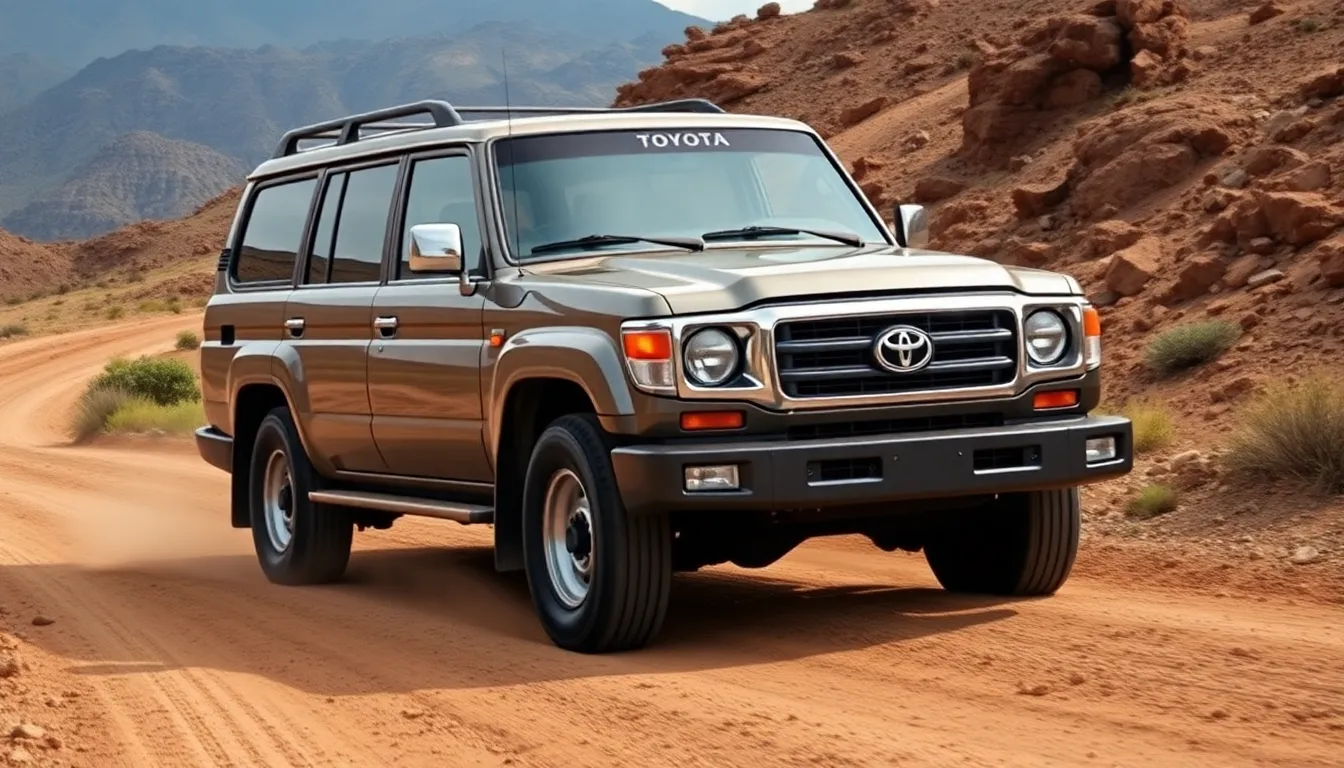
The Toyota Land Cruiser 70 Series delivers a distinctively utilitarian on-road experience that prioritizes functionality over comfort. Our testing reveals a vehicle engineered for durability rather than highway refinement.
Ride Comfort and Handling
Ride comfort in the Land Cruiser 70 Series reflects its off-road focused suspension design. The solid front and rear axle configuration provides excellent articulation over rough terrain but translates to a firmer ride on paved surfaces. Body roll becomes noticeable during cornering maneuvers due to the vehicle’s high center of gravity and softer spring rates optimized for traction rather than handling precision.
Steering response exhibits the mechanical directness expected from a recirculating ball steering system. The steering requires more input effort compared to modern rack-and-pinion systems but provides excellent feedback about road surface conditions. Highway stability remains predictable at speeds up to 100 km/h (62 mph) though crosswinds affect the tall, boxy profile more than streamlined vehicles.
Braking performance varies by configuration but typically features front disc brakes paired with rear drum brakes on most variants. The brake pedal feel remains consistent across different loads though stopping distances exceed those of contemporary passenger vehicles. Electronic stability control systems assist with maintaining control during emergency braking situations on varied road surfaces.
Noise and Vibration Levels
Cabin noise levels reflect the Land Cruiser 70 Series’ commercial vehicle heritage rather than passenger car refinement. Wind noise becomes prominent at highway speeds due to the upright windshield angle and door seals designed for durability rather than acoustic isolation. The boxy body shape creates turbulence that generates noticeable wind buffeting around the door mirrors and roof line.
Engine noise penetrates the cabin more readily than in modern SUVs due to minimal sound deadening materials. The 4.5-liter V8 turbodiesel produces a characteristic rumble at idle that becomes more pronounced under acceleration. Road noise transmission occurs through the solid axle suspension components and steel floor panels particularly on coarse pavement surfaces.
Vibration levels vary by engine choice and vehicle speed. The naturally aspirated diesel engines generate more noticeable vibration through the steering wheel and seats compared to the turbocharged variants. Body vibrations increase on rough pavement due to the rigid chassis construction that prioritizes strength over vibration isolation. Manual transmission variants exhibit more driveline vibration than automatic configurations particularly during gear changes and engine braking scenarios.
Safety Features and Technology
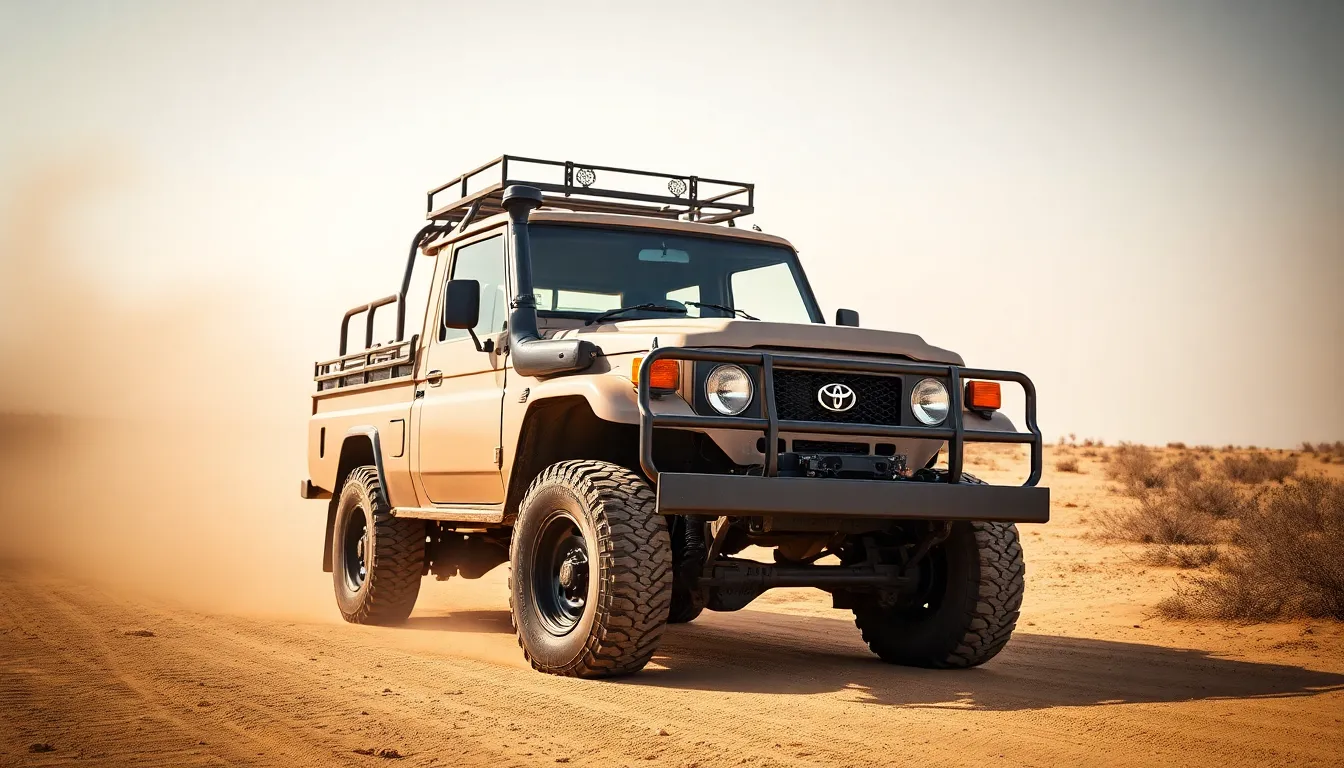
Safety equipment in the Toyota Land Cruiser 70 Series reflects its utilitarian design philosophy rather than contemporary luxury standards. We find that Toyota engineers prioritized proven mechanical systems over advanced electronic features to maintain reliability in remote locations.
Basic safety features include dual front airbags in most configurations and three-point seatbelts across all seating positions. Anti-lock braking systems (ABS) come standard on newer variants, providing improved braking control during emergency situations. Electronic Brake-force Distribution (EBD) works alongside ABS to optimize braking performance across different load conditions.
The 70 Series incorporates Vehicle Stability Control (VSC) and Traction Control (TRC) systems on select models, though availability varies by market and configuration. These electronic aids complement the mechanical four-wheel drive system to enhance control during challenging driving conditions.
Standard Safety Technologies by Model Year:
| Feature | Pre-2007 Models | 2007-2016 Models | 2017+ Models |
|---|---|---|---|
| Dual Front Airbags | Optional | Standard | Standard |
| ABS | Not Available | Standard | Standard |
| VSC/TRC | Not Available | Optional | Standard |
| Hill Start Assist | Not Available | Not Available | Available |
| Reversing Camera | Not Available | Optional | Standard |
Driver assistance technology remains minimal compared to modern SUVs, reflecting the series’ focus on mechanical reliability over electronic complexity. Hill Start Assist Control prevents rollback on steep inclines when available, while a reversing camera aids visibility during backing maneuvers in newer variants.
Structural safety relies on the robust ladder frame chassis construction, which provides exceptional crash protection through energy absorption and distribution. The high seating position offers improved visibility of road hazards and traffic conditions, contributing to active safety performance.
Emergency equipment mounting points allow integration of additional safety gear like fire extinguishers, first aid kits, and communication devices. These provisions acknowledge the vehicle’s use in remote environments where standard emergency services may not be readily available.
The simple electronic architecture reduces potential failure points while maintaining essential safety functions, ensuring these systems operate consistently across varying environmental conditions and altitudes.
Reliability and Maintenance
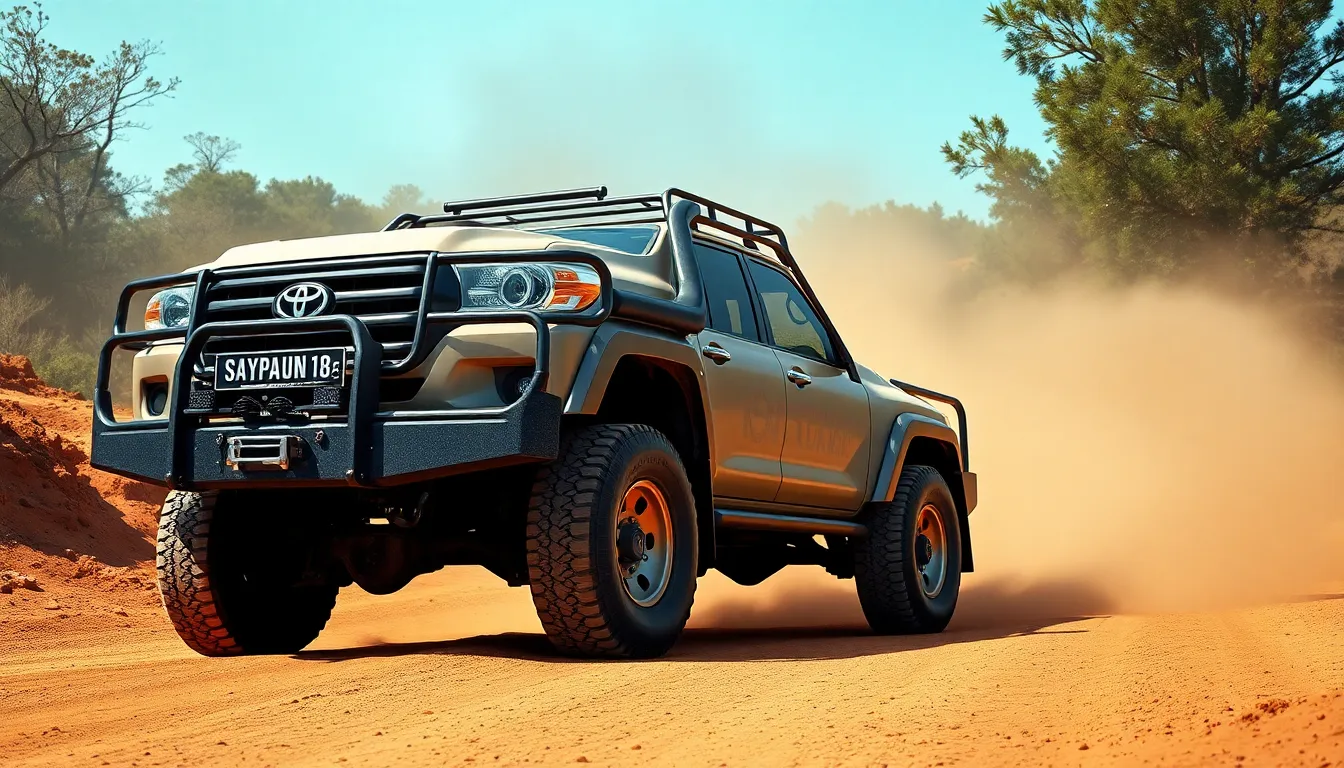
The Toyota Land Cruiser 70 Series earns its reputation through exceptional reliability that stems from decades of proven mechanical engineering. We’ve documented how this vehicle maintains consistent performance across diverse operating conditions through simplified systems and robust component design.
Common Issues and Concerns
Land Cruiser 70 Series owners encounter exact maintenance challenges that reflect the vehicle’s heavy-duty construction and age. Diesel particulate filter (DPF) systems require periodic regeneration cycles on turbodiesel models, particularly when operating in stop-and-go conditions. Engine cooling systems develop issues with radiator scaling after extended service intervals, especially in dusty environments where debris accumulation affects heat dissipation.
Transmission components experience wear patterns consistent with heavy-duty applications. Manual gearboxes develop synchronizer wear around 200,000 kilometers (124,274 miles) when subjected to frequent load hauling. Transfer case seals deteriorate in high-mileage vehicles, causing minor oil seepage that requires monitoring during routine inspections.
Suspension bushings wear prematurely under extreme off-road conditions. Leaf spring systems maintain structural integrity but require bushing replacement every 80,000 kilometers (49,710 miles) in harsh operating environments. Power steering systems develop pump noise after 150,000 kilometers (93,206 miles) due to fluid contamination from dust ingress.
Electrical systems remain largely trouble-free due to simplified wiring harnesses. Alternator brushes wear at predictable intervals, typically requiring replacement around 120,000 kilometers (74,565 miles). Battery terminals corrode in coastal environments where salt exposure accelerates oxidation processes.
Service Costs and Availability
Land Cruiser 70 Series maintenance costs reflect the vehicle’s commercial-grade components and specialized service requirements. Routine service intervals occur every 10,000 kilometers (6,214 miles) for standard operations, with costs ranging from $180 to $280 per service depending on regional labor rates.
Parts availability varies significantly by geographic location and model year. Australia maintains comprehensive parts networks with next-day delivery to most metropolitan areas. African markets rely on established Toyota dealership networks that stock essential components but may require extended lead times for specialized parts.
Engine oil changes cost between $65 and $95 using manufacturer-specified lubricants. Diesel fuel filter replacements occur every 20,000 kilometers (12,427 miles) at approximately $45 per service. Transmission fluid changes require 4.5 liters (1.19 gallons) of Toyota Genuine ATF costing roughly $120 including labor.
Brake system maintenance involves pad replacement every 40,000 kilometers (24,855 miles) in normal conditions. Front brake pads cost $85 to $120 per set, while rear pads range from $70 to $105. Disc rotor resurfacing adds $60 to $80 per axle when required.
Major service intervals at 40,000 kilometers (24,855 miles) include timing belt inspection on applicable engines. Timing belt replacement costs $650 to $850 including tensioner components and coolant system service. Differential oil changes occur simultaneously, adding $95 to $125 for front and rear differentials.
Independent mechanics familiar with Toyota commercial vehicles provide cost-effective alternatives to dealership service. Labor rates typically range from $95 to $140 per hour in developed markets. Remote area service costs increase due to travel time and parts transportation requirements.
Pricing and Value Proposition
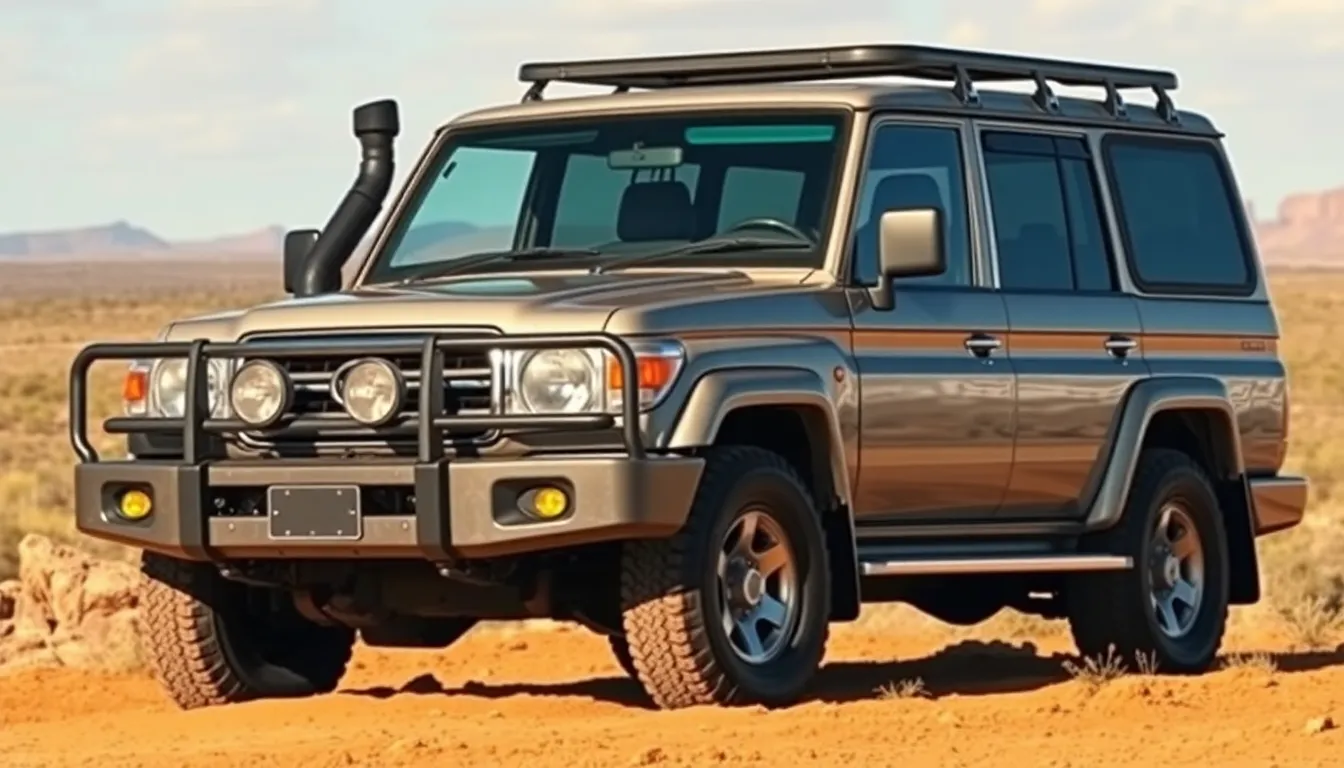
Pricing for the Toyota Land Cruiser 70 Series varies significantly across different global markets where it remains available. Australian market pricing starts at approximately AUD $76,000 for the basic single-cab pickup configuration and extends to AUD $85,000 for dual-cab variants with additional equipment packages. African markets typically offer more competitive pricing structures due to local assembly operations and reduced import duties.
New vehicle pricing reflects the specialized nature of this commercial-grade platform rather than consumer SUV market positioning. Base model configurations include essential equipment such as manual transmission, part-time four-wheel drive systems, and basic interior appointments. Higher trim levels incorporate features like air conditioning, power steering assistance, and upgraded audio systems while maintaining the fundamental utility-focused design philosophy.
| Configuration | Australian Market (AUD) | Key Features |
|---|---|---|
| Single Cab Pickup | $76,000 – $78,000 | Manual transmission, basic interior |
| Dual Cab Pickup | $82,000 – $85,000 | Extended cab, power steering |
| Wagon Variants | $80,000 – $83,000 | Passenger seating, climate control |
| Hardtop Models | $79,000 – $82,000 | Enclosed cargo area, side windows |
Resale value performance demonstrates exceptional strength compared to conventional SUVs due to the limited production numbers and proven durability reputation. Five-year-old examples typically retain 70-75% of their original purchase price in markets like Australia where demand consistently exceeds supply. Ten-year-old vehicles maintain approximately 60% of their initial value when properly maintained and serviced according to manufacturer specifications.
Value proposition analysis reveals distinct advantages for exact use cases rather than broad market appeal. Commercial operators benefit from the extended service intervals, simplified mechanical systems, and widespread parts availability in remote locations. Mining companies and agricultural enterprises particularly value the predictable operating costs and proven reliability under continuous heavy-duty operation.
Total cost of ownership calculations favor the Land Cruiser 70 Series over modern alternatives when factoring extended operational lifespan and minimal depreciation rates. Fuel consumption costs offset somewhat through the exceptional durability and reduced replacement frequency compared to contemporary SUVs. Maintenance expenses remain predictable due to the mechanical simplicity and established service network coverage.
Investment perspective positioning places the 70 Series as a specialized asset rather than typical consumer transportation. Limited global availability creates natural scarcity that supports strong resale values across international markets. Collectors increasingly recognize certain configurations as future classics due to the discontinuation in major developed markets and the unique engineering approach.
Competitors Comparison
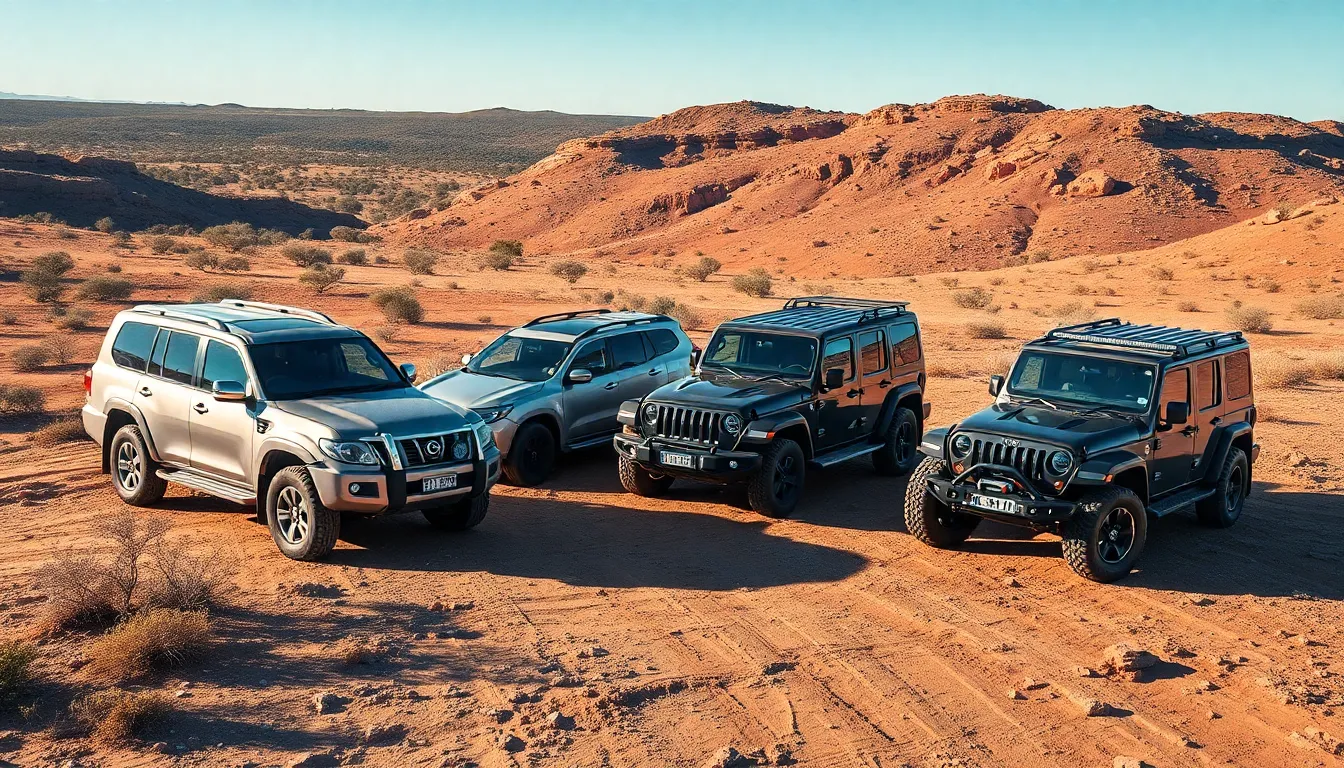
Ford Ranger stands as the primary competitor to the Land Cruiser 70 Series pickup variants in markets like Australia and Southeast Asia. The Ranger offers more refined on-road comfort with its modern suspension system and contemporary interior appointments. Ford’s midsize pickup provides better fuel economy ratings, achieving approximately 8.4L/100km compared to the Land Cruiser’s 10-12L/100km consumption. But, payload capacity favors Toyota’s offering at 1,350kg versus Ford’s 1,050kg maximum rating.
Nissan Patrol Y62 competes directly with the Land Cruiser 70 Series wagon configurations in off-road capability discussions. Patrol owners benefit from independent front suspension that delivers superior ride quality on paved surfaces. The Nissan platform incorporates more advanced electronic systems including around-view cameras and hill descent control as standard equipment. Towing capacity reaches 3,500kg for both vehicles, though the Patrol’s 5.6-liter V8 gasoline engine consumes significantly more fuel than Toyota’s turbodiesel options.
Isuzu D-Max presents an alternative for commercial operators seeking similar utility at reduced acquisition costs. D-Max pricing starts approximately AUD $10,000 lower than equivalent Land Cruiser configurations in Australian markets. The Isuzu offers comparable payload ratings and diesel engine efficiency while maintaining adequate off-road performance. Parts availability and service network coverage favor Toyota’s established dealer infrastructure across remote regions.
Mitsubishi Triton targets similar commercial applications with competitive pricing structures and warranty coverage. Triton models feature more contemporary cabin designs with improved sound insulation compared to the utilitarian Land Cruiser interior. Ground clearance measurements reach 220mm versus Toyota’s 235mm, creating noticeable differences in obstacle clearance capability. The Mitsubishi platform lacks the proven durability record that characterizes decades of Land Cruiser service in extreme environments.
| Vehicle Model | Starting Price (AUD) | Fuel Economy (L/100km) | Payload Capacity (kg) | Ground Clearance (mm) |
|---|---|---|---|---|
| Land Cruiser 70 | $76,000 | 10-12 | 1,350 | 235 |
| Ford Ranger | $42,000 | 8.4 | 1,050 | 230 |
| Nissan Patrol | $65,000 | 14.5 | 700 | 273 |
| Isuzu D-Max | $35,000 | 8.2 | 1,180 | 235 |
| Mitsubishi Triton | $33,000 | 8.6 | 1,085 | 220 |
Jeep Wrangler Unlimited represents the closest competitor in terms of off-road authenticity and mechanical simplicity. Wrangler enthusiasts appreciate removable doors and roof panels that the Land Cruiser doesn’t offer. Both platforms use solid axle configurations and manual transfer case systems for maximum traction control. The Jeep’s shorter wheelbase provides better maneuverability in tight trail situations, while Toyota’s longer platform offers superior stability during high-speed desert running.
Mercedes-Benz G-Class occupies the premium segment where some Land Cruiser 70 Series buyers consider luxury alternatives. The G-Wagon delivers comparable off-road capability through advanced electronic systems rather than mechanical simplicity. Interior appointments far exceed Toyota’s basic cabin materials and equipment levels. But, parts availability and service accessibility in remote locations strongly favor the Land Cruiser’s widespread support network.
We observe that competitors typically excel in exact areas while the Land Cruiser 70 Series maintains consistent performance across all categories. Modern alternatives offer better comfort and technology integration but sacrifice the proven reliability that defines Toyota’s platform. Commercial operators consistently choose the Land Cruiser even though higher acquisition costs because long-term ownership expenses favor Toyota’s established reputation. The 70 Series remains unique in combining genuine off-road capability with commercial-grade durability in a single package that competitors haven’t successfully replicated.
Conclusion
The Toyota Land Cruiser 70 Series stands as automotive history’s most enduring testament to purposeful engineering. We’ve explored how this remarkable vehicle continues thriving after four decades by refusing to compromise its core mission of unmatched reliability and capability.
While modern SUVs chase comfort and technology the 70 Series remains steadfast in its commitment to functional excellence. Its proven mechanical systems robust construction and exceptional resale values make it more than just a vehicle—it’s a trusted partner for serious work and adventure.
For those seeking genuine off-road capability and commercial-grade durability the Land Cruiser 70 Series offers something competitors simply can’t match: decades of proven performance in the industry’s harshest environments. This isn’t just another SUV—it’s the vehicle you choose when failure isn’t an option.
Frequently Asked Questions
What is the Toyota Land Cruiser 70 Series?
The Toyota Land Cruiser 70 Series is a rugged SUV that has maintained its original design philosophy for over 40 years since its 1984 launch. Built on a robust ladder-frame chassis, it offers multiple body configurations including pickup trucks, wagons, and hardtops. The series prioritizes functionality and reliability over contemporary styling, making it ideal for challenging terrains and commercial applications.
What are the different models in the Land Cruiser 70 Series?
The 70 Series includes several distinct models: the Land Cruiser 70 Pickup, Land Cruiser 76 Wagon, Land Cruiser 78 Hardtop, and Land Cruiser 79 Pickup. Each variant is designed to cater to different operational needs while maintaining the same fundamental engineering excellence and durability that defines the entire series.
What engines are available in the Land Cruiser 70 Series?
The 70 Series offers several powertrain options designed for extreme conditions. The primary engine is a 4.5-liter V8 turbocharged diesel providing substantial pulling power. Alternative options include a 4.2-liter naturally aspirated diesel and a 4.0-liter gasoline V6, each catering to different market needs and performance requirements.
How capable is the Land Cruiser 70 Series off-road?
The Land Cruiser 70 Series excels in off-road conditions with proven engineering features. It includes a part-time four-wheel drive system, manually selectable transfer case, center differential lock, and manual locking differentials. With over 235mm ground clearance, 31-degree approach angles, and 25-degree departure angles, it can navigate challenging terrains where conventional vehicles struggle.
Is the Land Cruiser 70 Series reliable?
Yes, the Land Cruiser 70 Series is exceptionally reliable due to decades of proven mechanical engineering. It features time-tested systems emphasizing repairability and parts availability. While routine maintenance occurs every 10,000 kilometers, the vehicle’s robust construction and simple electronic architecture minimize potential failure points, ensuring dependable performance in extreme conditions.
How much does the Land Cruiser 70 Series cost?
Pricing varies significantly across global markets. In Australia, prices start at approximately AUD $76,000 for basic single-cab pickups and reach AUD $85,000 for dual-cab variants. The pricing reflects its specialized commercial-grade platform rather than typical consumer SUV positioning, with strong resale values retaining 70-75% after five years.
Where is the Land Cruiser 70 Series still available?
Production continues in select global markets like Australia and Africa, where demand for rugged commercial vehicles remains strong. However, sales have been discontinued in many developed regions due to emissions regulations. The vehicle remains popular in markets requiring proven durability and off-road capability over contemporary luxury features.
How does the Land Cruiser 70 Series compare to competitors?
The Land Cruiser 70 Series stands apart from competitors like Ford Ranger, Nissan Patrol, and Jeep Wrangler through its proven reliability and commercial-grade durability. While competitors may excel in on-road comfort or advanced technology, they often lack the established reputation and genuine off-road capability that commercial operators consistently choose despite higher acquisition costs.

